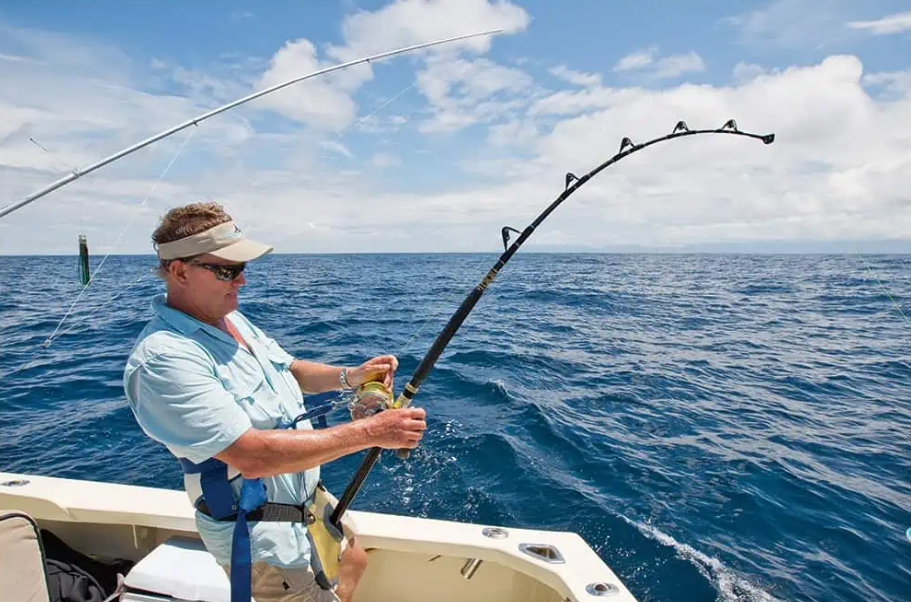In general, many saltwater fishing rods must be thicker and heavier than freshwater rods, and depending on the species, certain saltwater fish (such as marlin or sharks) can weigh thousands of pounds. Heavy offshore saltwater fishing rods are usually made of fiberglass for greater durability.
Fishing is a beloved pastime that brings joy and relaxation to anglers all around the world. Whether you’re an experienced angler or just starting out, choosing the right fishing gear is crucial to maximize your success and enjoyment on the water. One of the most fundamental choices to make is selecting the appropriate fishing rod.
In this article, we will explore the key differences between saltwater and freshwater fishing rods, highlighting their unique features, materials, and considerations to help you make an informed decision for your fishing adventures.
Environment and Target Species
The most significant distinction between saltwater and freshwater fishing rods lies in the environment and the species they are designed to catch.
a. Saltwater Fishing Rods: Saltwater fishing rods are specifically engineered to withstand the harsh conditions of the ocean environment. The salt, sand, and exposure to the elements demand higher levels of corrosion resistance and durability. Additionally, saltwater species tend to be larger and more powerful, requiring rods with greater strength and backbone to handle the fight.
b. Freshwater Fishing Rods: Freshwater fishing rods are tailored for use in lakes, rivers, ponds, and other freshwater bodies. Since the environment is generally less corrosive, freshwater rods do not need the same level of corrosion resistance as saltwater rods. Freshwater species are generally smaller and less aggressive, so these rods are designed with more finesse and sensitivity to detect light bites and provide a more enjoyable experience for smaller catches.
Material Composition
The materials used in constructing fishing rods significantly impact their performance and durability.
a. Saltwater Fishing Rods: Saltwater fishing rods are typically crafted from materials that offer superior corrosion resistance, such as graphite, fiberglass, or a combination of both. Graphite rods are favored for their lightweight and sensitive properties, making them suitable for long casting distances and detecting subtle strikes. On the other hand, fiberglass rods offer exceptional strength and are less prone to breaking, making them ideal for battling powerful saltwater species.
b. Freshwater Fishing Rods: Freshwater fishing rods can also be made from graphite and fiberglass, but they may utilize a higher percentage of graphite to enhance sensitivity and responsiveness for lighter bites. Graphite rods are commonly preferred by freshwater anglers due to their versatility and ability to target various species.
Rod Action and Power
Rod action and power are essential considerations when choosing a fishing rod as they dictate its flexibility and ability to handle different lure weights and fish sizes.
a. Saltwater Fishing Rods: Saltwater fishing rods typically have a faster action and higher power rating to handle the larger and more aggressive fish found in ocean waters. The faster action allows for longer casting and better hook sets, while the higher power provides the backbone needed to control powerful fights.
b. Freshwater Fishing Rods: Freshwater fishing rods come in a range of actions and powers, catering to different angling styles and species. Light or medium-light rods with moderate actions are suitable for finesse techniques and targeting smaller fish, while medium to medium-heavy rods with fast actions are more versatile and can handle a wider range of freshwater species.
Reel Types
a. Saltwater Fishing Rods: Saltwater fishing rods are often paired with specialized saltwater reels that offer enhanced corrosion resistance. These reels are typically made with stainless steel, aluminum, or other corrosion-resistant materials. Saltwater reels also come with additional seals and gaskets to prevent saltwater intrusion, ensuring smooth operation even in harsh conditions.
b. Freshwater Fishing Rods: Freshwater fishing rods are commonly matched with freshwater reels, which may not have the same level of corrosion resistance as their saltwater counterparts. However, freshwater reels are generally lighter and designed for more precise and lighter line control, which is suitable for the finesse techniques often used in freshwater fishing.
Line Weight and Capacity
a. Saltwater Fishing Rods: Saltwater fishing rods are designed to handle heavier line weights and larger spools, as saltwater species tend to be bigger and more powerful. The larger spool capacity allows for more line, which is crucial when dealing with aggressive fish that make long runs.
b. Freshwater Fishing Rods: Freshwater fishing rods are built to accommodate lighter line weights and smaller spools since freshwater species are generally smaller and less aggressive. Lighter lines allow for more finesse presentations and better sensitivity, which is essential for detecting subtle strikes in freshwater environments.
Guides and Materials
a. Saltwater Fishing Rods: Saltwater fishing rods often feature more robust and corrosion-resistant guides to withstand the abrasive effects of saltwater and prevent line damage. Guides may be constructed from materials like stainless steel or other high-quality materials that can endure exposure to salt.
b. Freshwater Fishing Rods: Freshwater fishing rods also have guides designed to be lighter and more sensitive to complement the overall finesse characteristics of the rod. These guides may be made from materials like aluminum oxide or ceramic, which offer smooth line flow and sensitivity for detecting light nibbles from freshwater species.
Length and Handle Design
a. Saltwater Fishing Rods: Saltwater fishing rods tend to be longer than their freshwater counterparts, often ranging from 7 to 12 feet. The extra length allows for longer casting distances from the shore or a boat, which is beneficial when targeting fish in vast ocean expanses. Additionally, saltwater rods may have specialized handles with non-slip materials to provide a better grip in wet conditions.
b. Freshwater Fishing Rods: Freshwater fishing rods come in a wider variety of lengths, ranging from ultralight 4-foot rods for small creeks to longer 8-foot rods for open water casting. The choice of length depends on the angler’s preferences and the type of fishing they plan to do. Handles on freshwater rods are designed with comfort in mind, and some may even incorporate ergonomic features for extended use.
Conclusion about What Is the Difference Between Saltwater and Freshwater Fishing Rods
In summary, saltwater and freshwater fishing rods differ in several key aspects, all tailored to optimize performance in their respective environments. Whether you’re planning an adventurous deep-sea fishing trip or a serene day at a peaceful lake, choosing the right fishing rod will greatly impact your overall fishing experience.
Remember to consider the environmental conditions, target species, materials, rod action, reel type, line weight, and handle design when making your selection. Investing in a suitable fishing rod will not only increase your chances of landing that prized catch but also add to the enjoyment and satisfaction you derive from your angling endeavors.
Lastly, no matter which fishing rod you choose, always remember to practice responsible fishing, follow local regulations, and respect the natural ecosystem. Tight lines and happy fishing!

